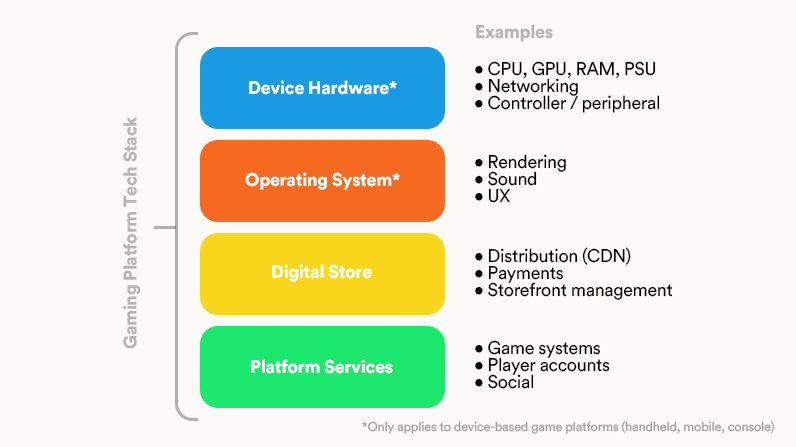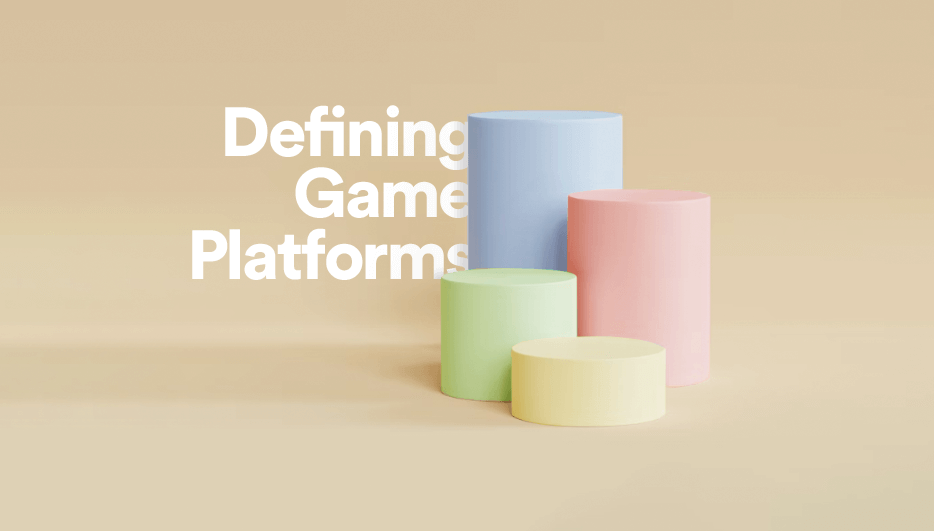In recent years the definition of what constitutes a ‘game platform’ has expanded significantly.
Today traditional platforms such as games consoles have been joined by all manner of new contenders. From individual games like Roblox to streaming services such as Netflix, via plucky underdogs including itch.io, there are now a great many interpretations of what a ‘game platform’ can be. This also means there is an emerging opportunity to redefine the game platform as a concept, and establish a model that hands more power back to developers and publishers.
Game platforms as a technology stack
The most helpful way to think about a game platform is as a technology stack. Today there are two broad categories of game platform; physical and digital. Physical platforms would include the likes of console, PC and mobile, while digital platforms would include options such as Steam, Epic Games Store, Netflix, Roblox, itch.io, publisher portals, and even social media destinations such as Snapchat and TikTok, where games are increasingly available.
So, let’s look at a typical game technology stack. It’s worth noting at this point that digital platforms have no inherent client-side hardware (beyond a screen or access device) or purebred operating system to speak of. However, the specifications and performance of those platforms can be understood in a similar way to physical platforms. It is just that the equivalents to hardware and operating systems exist server-side, far from the player.

As we can see from the graphic above, a game platform technology stack has four main elements:
1. Device Hardware
In a game platform context, ‘device hardware’ is the physical hardware used to play games. The most typical examples are console, PC, and mobile. Device hardware ultimately dictates the performance and capability behind the games. CPU, GPU, RAM, PSU, and so on are all determined by device hardware. Similarly, the likes of networking ability are set by device hardware. Controllers and peripherals can be seen as an extension of device hardware. PC presents a slightly distinct example here, where the provider of the hardware (perhaps Dell or Acer, for example), is not the same entity as the owner of the rest of the tech stack. Console and mobile operators such as Nintendo or Apple, meanwhile, own most or all of their tech stacks.
2. Operating System
An operating system is the bridge between hardware and user. It provides a front end, a consistent ecosystem and set of user-facing tools for interaction, and a means through which to operate the hardware itself – and all other apps and games found on that hardware. An operating system (commonly ‘OS’) also provides and manages more specific abilities and performance around the likes of rendering, audio, UX, UI, and more. Windows and iOS are some of the most famous operating systems. PlayStation and Xbox front ends are also operating systems.
3. Digital Store
In a game platform context, a digital store is a form of ‘content delivery network’ (CDN). Before games were so online, this element of the tech stack essentially did not exist. But now digital stores don’t just provide a way to purchase and download games and apps. They also allow for updates and patching, DLC, in-game payments, and so on. Most are built around the foundation of a payment system and storefront management system. Steam and others like it can be seen to have expanded the digital storefront concept to offer a full game platform. Today game backend services can provide much of the solutions offered by a digital store, in place of the game platform itself; something that enables some games that exist outside of first or third-party platforms. Example of such games running on their own platform include League of Legends, Minecraft, and Escape from Tarkov.
4. Platform Services
Platform services often serve the players, but are provided to developers and publishers to integrate with. They are essentially the connective tissue that ties a game platforms’ players and games together, such as your friend’s list, achievements, leaderboards, and even your player account, inventory, and activity. When people talk about wanting cross-play in their games, it is often the platform services that are the things holding games back, as the information stored in the player’s profile in platform A needs to be shared with platform B.
A note on walled gardens vs. open platforms
The landscape of game platforms can be broadly divided into two types. Consoles offer an example of traditional ‘walled garden’ platforms, where the platform owner controls the hardware, OS, digital storefront, and platform services. They will also gatekeep access to publishing on the platform, insist certain technologies and tools are used, and control what is published through the likes of certification. This gives developers a complete, integrated ecosystem, but much less freedom over what to publish, how to maintain it, and the relationship with players.
Open platforms are a newer model, of which itch.io is an early example. Open platforms essentially put up no or very minimal barriers to publishing games, and are more welcoming of developers using their preferred cocktail of tools and services, from pre-production to post-launch maintenance.
In the years ahead, we are likely to see traditional walled garden game platforms open up or diminish in presence, while open platforms that put players, developers and publishers first are on the rise. The future of game platforms is a very exciting place.
